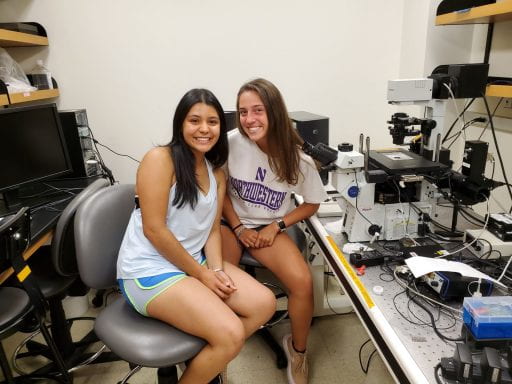Undergraduates mentored as a Postdoctoral Fellow at Northwestern University
Jimena Collado – Jimena, a sophomore, is currently working in tandem with Cameron to investigate the relationship between nuclear blebbing and DNA damage. Jimena is also working with Cameron and I as part of the 4D Nucleome NIH consortium to determine the role of HP1-alpha in nuclear mechanics, morphology, and function via a novel auxin degradable version of this protein.
Cameron Herman – Cameron, a junior, is currently investigating how abnormal nuclear morphology and blebbing can disrupt the basic functions of the cell nucleus. Specifically, she is interrogating the relationship between DNA damage and nuclear blebbing. Cameron aid analysis to show, for the first time, that cells with nuclear blebs have on average and consistently two-fold higher levels of DNA damage in our recent publication (Stephens and Liu, et al., MBoC 2019).
Viswajit (Vis) Kandula – Vis, a senior, is currently performing nuclear blebbing assays and immunofluorescence imaging for our project investigating how extracellular signals influence heterochromatin formation in the cell nucleus to influence nuclear mechanics and morphology (Stephens and Liu, et al., MBoC 2019). Vis helped build/engineer a new micropipette micromanipulation microscope (the second of its kind in the USA, last built in 1998) and developed/updated custom software to run the microscope and its associated experiments. Check out our Micromanipulation microscope 1.5 page to see more details. Vis is currently in medical school at Northwestern University Feinberg School of Medicine.
Patrick Z. Liu – Patrick, alumni, is second author on our published paper on chromatin-based nuclear blebbing (Stephens, Liu, et al., MBoC 2018). Patrick is also a co-first author on our recently publihsed paper investigating how extracellular signals influence heterochromatin formation in the cell nucleus to influence nuclear mechanics and morphology (Stephens and Liu, et al., MBoC 2019). Patrick also is a second author on a lab paper studying the effects of altering histone post-translational modifications on mitotic chromosome structure and mechanics (Biggs et al., MBoC 2019). Patrick is currently a Fulbright U.S. Student Program, South Korea English Teaching Assistant. Patrick recently recieved the Marshall Fellowship and is currently doing a Ph.D. at Oxford.
[Top – Summer 2019 – from left to right : Jimena Collado and Cameron Herman (undergrad researchers) next to there microscope / Bottom Left – Summer 2018 – from left to right : Andrew D. Stephens (me, Postdoctroal Fellow), Viswajit Kandula (undergrad research), Cameron Herman (undergrad research) , and our newly built Micromanipulation microscope 1.5 / Bottom Right – Summer 2017 – from left to right: Patrick Z. Liu (undergrad research), Viswajit Kandula (undergrad research), Andrew D. Stephens (me, Postdoctroal Fellow), Edward J. Banigan (physics collaborator, Postdoctoral Fellow at MIT) ]
Undergraduates mentored as a graduate student at the University of North Carolina at Chapel Hill
Laura Fulbright – currently Research Assistant II at Vanderbilt University Medical Center
Rachel (Rei) A. Haggerty – middle author on three papers as an undergraduate researcher, currently a graduate student at University of North Carolina at Chapel Hill
Chloe E. Snider – first author on one paper and middle author on four papers as an undergraduate researcher, currently a graduate student at Vanderbilt University
Binny Chang M.D. – second author on one paper as an undergraduate researcher, currently at the University of South Dakota Internal Medicine Residency. M.D. from St. George’s University School of Medicine, Grenada
Outline of my Research Mentoring Strategy
Through my experience mentoring undergraduates, I have developed a system encompassing four major points – Priority, Think, Communicate, and Repeat – to guide young scientists through becoming an independent thinker and working in a lab setting.
Priority represents taking care of life and school before lab, but when a student is in lab they should be focused on lab. For more experienced students, Priority shifts to managing time and putting effort into the most worthy tasks.
Think forces the development of an independent thinker by challenging the scientist to provide an answer to any question they want to ask (right or wrong). Young scientists ask questions without thinking and expect to get an answer that they may not even learn from, comprehend, or be able to apply in the future. Instead the idea “bring me a solution, not a problem” forces independent thinking by forcing the student to ask both meaningful questions and develop a hypothesis for the answer or how to answer the question. Furthermore, Think also applies to being mindful during experiments to either focus on a task at hand or to question or learn about a procedure to help the student realize, “why am I doing, what I am doing?”
Communicate builds on the foundation of Think by forcing a student to ask and answer questions with others in lab. More specifically, Communicate drives conversations that will reveal the student’s true level of knowledge since communication demonstrates their level of understanding. Divulging this information allows me or other lab members to teach the student whatever they do not understand or know. Finally, Communicate includes a focus on the fact that data is meaningless unless you can covey your findings to others. More specifically this is encompassed in preparation and implementation of science presentations (poster, talks, lab meetings, conferences, papers, grants, etc.).
Repeat speaks to the importance of practicing to improve while acknowledging that failure is just a stepping stone to success. It also highlights that repetition and recapitulation are key parts of science. Ultimately, Repeat reinforces the repetition of these four points over and over and day-to-day to guide the growth of an independent thinker in training.
Overall, my guide to developing an independent thinker is based on scientific tools to ask and answer good questions while engaging with other members in the lab daily. My approach strives to create a learning environment to encourage an active and engaging mindset that becomes equipped to overcome challenges in school, work, and life.

